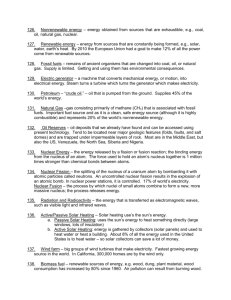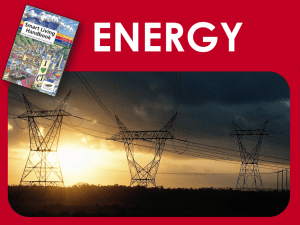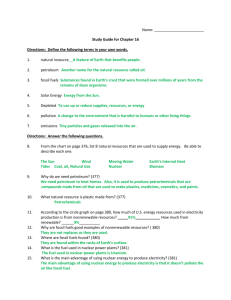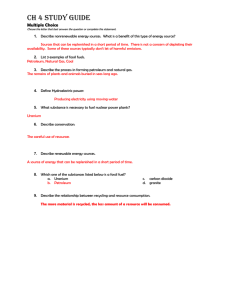Character Education Newsletter for Middle
advertisement
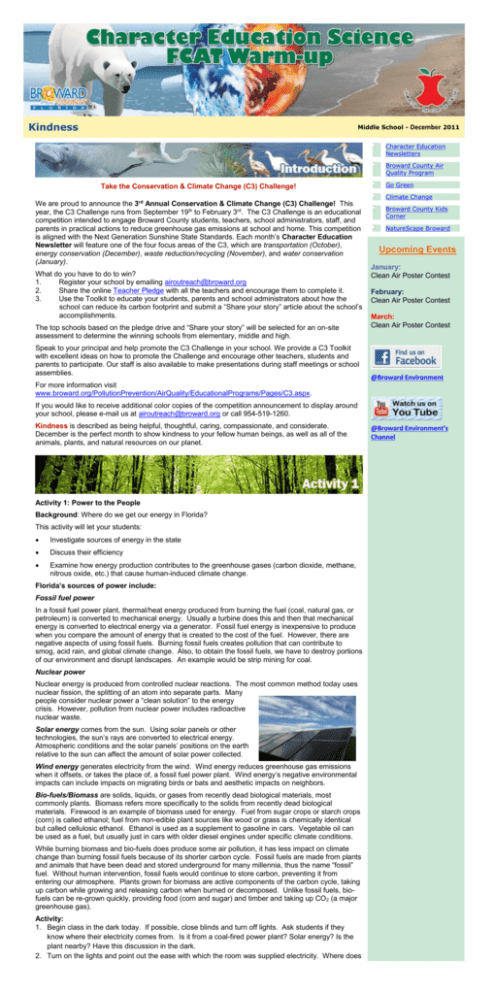
Kindness Middle School - December 2011 Character Education Newsletters Broward County Air Quality Program Take the Conservation & Climate Change (C3) Challenge! We are proud to announce the 3rd Annual Conservation & Climate Change (C3) Challenge! This year, the C3 Challenge runs from September 19th to February 3rd. The C3 Challenge is an educational competition intended to engage Broward County students, teachers, school administrators, staff, and parents in practical actions to reduce greenhouse gas emissions at school and home. This competition is aligned with the Next Generation Sunshine State Standards. Each month’s Character Education Newsletter will feature one of the four focus areas of the C3, which are transportation (October), energy conservation (December), waste reduction/recycling (November), and water conservation (January). What do you have to do to win? 1. Register your school by emailing airoutreach@broward.org 2. Share the online Teacher Pledge with all the teachers and encourage them to complete it. 3. Use the Toolkit to educate your students, parents and school administrators about how the school can reduce its carbon footprint and submit a “Share your story” article about the school’s accomplishments. The top schools based on the pledge drive and “Share your story” will be selected for an on-site assessment to determine the winning schools from elementary, middle and high. Speak to your principal and help promote the C3 Challenge in your school. We provide a C3 Toolkit with excellent ideas on how to promote the Challenge and encourage other teachers, students and parents to participate. Our staff is also available to make presentations during staff meetings or school assemblies. Go Green Climate Change Broward County Kids Corner NatureScape Broward Upcoming Events January: Clean Air Poster Contest February: Clean Air Poster Contest March: Clean Air Poster Contest @Broward Environment For more information visit www.broward.org/PollutionPrevention/AirQuality/EducationalPrograms/Pages/C3.aspx. If you would like to receive additional color copies of the competition announcement to display around your school, please e-mail us at airoutreach@broward.org or call 954-519-1260. Kindness is described as being helpful, thoughtful, caring, compassionate, and considerate. December is the perfect month to show kindness to your fellow human beings, as well as all of the animals, plants, and natural resources on our planet. Activity 1: Power to the People Background: Where do we get our energy in Florida? This activity will let your students: Investigate sources of energy in the state Discuss their efficiency Examine how energy production contributes to the greenhouse gases (carbon dioxide, methane, nitrous oxide, etc.) that cause human-induced climate change. Florida’s sources of power include: Fossil fuel power In a fossil fuel power plant, thermal/heat energy produced from burning the fuel (coal, natural gas, or petroleum) is converted to mechanical energy. Usually a turbine does this and then that mechanical energy is converted to electrical energy via a generator. Fossil fuel energy is inexpensive to produce when you compare the amount of energy that is created to the cost of the fuel. However, there are negative aspects of using fossil fuels. Burning fossil fuels creates pollution that can contribute to smog, acid rain, and global climate change. Also, to obtain the fossil fuels, we have to destroy portions of our environment and disrupt landscapes. An example would be strip mining for coal. Nuclear power Nuclear energy is produced from controlled nuclear reactions. The most common method today uses nuclear fission, the splitting of an atom into separate parts. Many people consider nuclear power a “clean solution” to the energy crisis. However, pollution from nuclear power includes radioactive nuclear waste. Solar energy comes from the sun. Using solar panels or other technologies, the sun’s rays are converted to electrical energy. Atmospheric conditions and the solar panels’ positions on the earth relative to the sun can affect the amount of solar power collected. Wind energy generates electricity from the wind. Wind energy reduces greenhouse gas emissions when it offsets, or takes the place of, a fossil fuel power plant. Wind energy’s negative environmental impacts can include impacts on migrating birds or bats and aesthetic impacts on neighbors. Bio-fuels/Biomass are solids, liquids, or gases from recently dead biological materials, most commonly plants. Biomass refers more specifically to the solids from recently dead biological materials. Firewood is an example of biomass used for energy. Fuel from sugar crops or starch crops (corn) is called ethanol; fuel from non-edible plant sources like wood or grass is chemically identical but called cellulosic ethanol. Ethanol is used as a supplement to gasoline in cars. Vegetable oil can be used as a fuel, but usually just in cars with older diesel engines under specific climate conditions. While burning biomass and bio-fuels does produce some air pollution, it has less impact on climate change than burning fossil fuels because of its shorter carbon cycle. Fossil fuels are made from plants and animals that have been dead and stored underground for many millennia, thus the name “fossil” fuel. Without human intervention, fossil fuels would continue to store carbon, preventing it from entering our atmosphere. Plants grown for biomass are active components of the carbon cycle, taking up carbon while growing and releasing carbon when burned or decomposed. Unlike fossil fuels, biofuels can be re-grown quickly, providing food (corn and sugar) and timber and taking up CO2 (a major greenhouse gas). Activity: 1. Begin class in the dark today. If possible, close blinds and turn off lights. Ask students if they know where their electricity comes from. Is it from a coal-fired power plant? Solar energy? Is the plant nearby? Have this discussion in the dark. 2. Turn on the lights and point out the ease with which the room was supplied electricity. Where does @Broward Environment’s Channel 3. 4. 5. 6. the power originate? Explain that students will investigate this today in class. Divide students into groups of three and verbally tell them the worksheet questions found below. Assign groups a power plant in Florida to investigate. If you do not have power plant information, allow students to use the internet. Students will work together to research sources of Florida’s electricity and electricity’s influence on climate change in Florida. The US Energy Information Administration and Florida Power & Light are good resources. When groups are finished, discuss their findings. Review percentages of energy source use and ask students to make hypotheses regarding the breakdown of use. Do the energy production resources need to be nearby? Discuss how power plants affect climate change in Florida. Keep in mind topics such as beach erosion, threatened species, tourism, the Everglades, and saltwater intrusion. Turn off the lights again. Ask students to think about worldwide energy usage and the climate change impacts of that energy use. When you turn them back on and, if time allows, have a brief discussion. Discussion Questions Why do you think power plants are located in certain areas of Florida? Availability of resources? Socio-economic factors? Population density? Transportation patterns? How efficient are these sources of energy? In what way do they affect Florida’s environment? How are these sources of energy linked to climate change? What are some ways that you can conserve energy? Worksheet Questions 1. What is the name of the power plant you are researching? 2. Where is the power plant located in Florida? List town/city and two nearby towns/cities. 3. What kind of energy source does your power plant use? Where is the source of the power plant’s fuel? 4. What types of emissions come from this power plant and how do they affect climate change? 5. Does the power company offer renewable energy? If yes, what types? 6. What three energy-saving actions are you most likely to take? Source: Wisconsin Department of Natural Resources – Climate Change: A Wisconsin Activity Guide, Grades 7-12 Activity 2: Energy Efficiency Reading Comprehension Read the following information to the class about energy, energy sources, and energy conservation. Afterwards, have a group discussion about conserving energy. Have the student’s think of as many renewable and non-renewable energy sources as they can and make a list. Ask students for suggestions on how to save energy and how they feel energy consumption will change in the future. Then have the students write a brief essay about energy. Topics may include types of energy available today in the United States, trends for the future, history of electricity, and a comparison on prices of utilizing various energy sources. Students should make use of the internet as well as library books, newspapers, and magazines for informational sources on energy. Energy comes in many different forms. Some sources of energy are renewable, meaning they can be replenished in a short period of time, while others are non-renewable sources. These come out of the ground as liquids, gases, and solids. Besides renewable and nonrenewable energy, there is also electricity. Electricity is the flow of electrical power or charge. It is a secondary energy source, which means that it is formed by the conversion of other sources of energy. These include coal, natural gas, oil, nuclear power, and other natural sources, which are called primary sources. The energy sources we use to make electricity can be renewable or non-renewable, but electricity itself is neither renewable nor non-renewable. Coal is the largest single primary source of energy used to generate electricity in the United States. In 2003, more than half (51%) of the country's 3.9 trillion kilowatt hours of electricity used coal as its source of energy. Unfortunately, coal is also a major source of pollution. Burning coal is a leading source of smog, acid rain, global warming, and toxic air pollutants. In an average year, a typical coal plant generates: 3,700,000 tons of carbon dioxide (CO2), the primary human source of global warming--as much carbon dioxide as cutting down 161 million trees 10,000 tons of sulfur dioxide (SO2), which causes acid rain that damages forests, lakes, and buildings, and forms small airborne particles that can penetrate deep into lungs 500 tons of small airborne particles, which can cause chronic bronchitis, aggravated asthma, and premature death, as well as haze which obstructs visibility 10,200 tons of oxides of nitrogen (NOx), as much as would be emitted by half a million late-model cars. NOx leads to the formation of ozone (smog) which inflames the lungs, burning through lung tissue making people more susceptible to respiratory illness 720 tons of carbon monoxide (CO), which causes headaches and places additional stress on people with heart disease Other sources of energy include nuclear power, hydropower, geothermal, solar, and wind power. Like all industrial processes, nuclear power generation has by-product waste: radioactive waste and heat. Because nuclear generated electricity does not emit carbon dioxide into the atmosphere, nuclear power plants in the U.S. prevent emissions of about 697 million metric tons of carbon dioxide. This is nearly as much carbon dioxide as is released from all U.S. passenger cars combined. However, radioactive waste is the principal environmental concern for nuclear power. Most nuclear waste is clothing, tools, and disposable items that have been contaminated with low levels of radioactive dust or particles. These materials are subject to special regulations that govern their storage so they will not come in contact with the outside environment. Of the renewable energy sources that generate electricity, hydropower is the most often used. It accounted for 7 percent of total U.S. electricity generation and 75 percent of generation from renewable sources in 2004. Solar energy can be converted directly or indirectly into other forms of energy, such as heat and electricity. The major drawbacks of solar energy are: (1) the intermittent and variable manner in which it arrives at the earth's surface and (2) the large area required to collect it at a useful rate. Solar energy is used for heating water for domestic use, space heating of buildings, drying agricultural products, and generating electrical energy. Like old fashioned windmills, today’s wind machines use blades to collect the wind’s kinetic energy. The wind flows over the airfoil shaped blades causing lift, like the effect on airplane wings, causing them to turn. The blades are connected to a drive shaft that turns an electric generator to produce electricity. Source: www.eia.doe.gov/kids/index.html Atoms are made of subatomic particles. Which of the following subatomic particles has the least mass? A. electron B. neutron C. nucleus D. proton Answer: A. electron Spread the Word!!! Subscribe to our FREE electronic Character Education Science FCAT Warm-up Newsletters Today! The monthly edition of this newsletter is distributed only through a FREE electronic e-mail subscriber list. E-mail the Broward County Air Quality program at airoutreach@broward.org to receive this valuable curriculum resource. The newsletters are also available on our Environmental Kids Club web site at www.broward.org/kids. Archived copies of the newsletter are also available through the School Board’s BEEP system. Need Ideas for the Upcoming Science Fair? Students can visit our Character Education Newsletter page at http://www.broward.org/Kids/CharacterEducation/Pages/CharacterEducation.aspx to view past newsletters and get great ideas for the upcoming Broward County Science Fair. Ideas can include: Build Your Own Watershed (March 2010) Calculate Your Personal Impact (September 2010) Cars & Carbon Dioxide (November 2009) Power To the People: Energy in Florida (October 2009) Shed 3 Tons in 10 Easy Steps (January 2009) Water Conservation Plan (March 2009) Other science fair ideas can be found online. By using a search engine, students can choose interesting themes such as: Is it Getting Hot in Here? Investigate the Greenhouse Effect Lead Levels in Local Soil Mapping Tropospheric Ozone Levels Over Time Recycling Greywater: Can Plants Tolerate It? Too Much of a Good Thing? Study the Effect of Fertilizers Source: www.sciencebuddies.org/science-fair-projects/recommender_interest_area.php?ia=EnvSci


